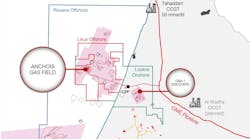William Furlow • Houston
Main Pass Gas Hub
McMoRan Exploration Co. has come one step closer to building an offshore LNG receiving and processing terminal using its existing structures at Main Pass block 299 in the Gulf of Mexico. The company announced last month that it has completed conceptual engineering on the Main Pass Energy Hub project and is preparing to file a licensing application with the US Coast Guard. The license would allow the facility to receive and process LNG and store and export gas from the facility.
The original mile-long, $1-billion jacket-and-bridge structure was put in place back in the early 1990s as part of a massive sulfur mining operation. The facilities have since been reconfigured with several jackets and topsides removed below the mudline. The remaining four platforms, two bridged and two freestanding, will be outfitted to process and store LNG. These large structures are robust enough to support the large, heavy regasification facilities needed to process the targeted 1 bcf/d of gas.
Dave Landry, vice president of Freeport McMoRan Energy, a McMoRan Exploration subsidiary, said the company originally designed this facility with a 40-year life, assuming the sulfur mining would continue for decades. As a result, the facility was over-designed, with topsides sitting 110 ft above the waterline.
The connected platforms still cover over a half-mile in length and stand in 210 ft water depth over a 2-mi-wide salt dome. This subsurface salt cavern, located 2,000 ft below the mudline, could be used to store the gas prior to export. The facilities are located within 5 mi of shipping lanes and in the midst of various gas trunk lines.
Landry said this complex has a number of advantages in the race to bring more LNG terminals to the US. Because it is located 17 mi offshore and 35 mi from the nearest town, Landry said it presents a reduced security risk compared to a shore-based facility. The Main Pass facility has large, relatively inexpensive storage capacity for processed gas and is in water deep enough to accommodate the custom-built super tankers that will deliver the LNG. With this extensive structure already in place, it is possible to fast track the project. Export options are numerous because of the proximity of trunklines.
.
The key technology that makes this facility possible is the Soft Berth mooring system, Landry said. This system comprises a set of two triangular semisubmersible units tethered to the seabed. These units provide a compliant buffer between the motions of the ship and the stationary platform, allowing for simple offloading of the LNG. Landry said his company developed this design with Bennett and Associates.
While awaiting Coast Guard approval, which will take up to a year, Landry said McMoRan will continue moving forward with the project and is proceeding with on-going design work for the facility. In addition, the company is seeking contracts with both LNG providers worldwide and various domestic consumers. Assuming government approval, Landry estimates the facility could be brought on line as early as 2006-2007.
Record turbines installed on Marlin Sul
Engineering company Peter Brotherhood Ltd. has installed the world's most powerful steam turbine alternator sets for an FPSO, the company says.
Each of the two turbo-alternator sets produces 12 MW of power. According to manufacturer Peter Brotherhood, this is as much as 50% more than any other in operation on an FPSO. The units were installed in Singapore onboard the FPSO Marlim Sul, which will eventually operate in the Marlim Sul field off the coast of Brazil.
The systems have been built for Single Buoy Moorings Inc., which operates the world's largest fleet of FPSOs. Peter Broth-erhood said the contract for the steam turbines is valued at £3.7 million.
The turbo alternator sets incorporate special features to enable them to operate reliably in a floating environment, where such things as the pitch and roll of a ship can affect performance. The geographic location in which turbo alternator sets will be installed and the harshness of sea conditions that could be encountered were also factors considered during design.
Schiedam-based IHC Gusto Engineering, sister company to SBM, provided design, engineering, and consultancy services for the Marlim Sul FPSO. The steam turbines were purchased by SBM Marly and were designed and manufactured to meet ABS requirements.
Each steam turbine, gearbox, and oil system was tested at Peter Brotherhood's manufacturing facility prior to dispatch. Engineers from the company will commission the machines onboard the vessel.
Subsea systems for Åsgard-Q
FMC Technologies has signed an agreement with Statoil to supply subsea production systems for Statoil's Åsgard-Q project in the North Sea.
The agreement includes three subsea trees and the associated structure, manifold, and production controls system. Åsgard-Q is part of the Åsgard field in the Norwegian sector of the North Sea, located in 1,000 ft of water 106 mi offshore. Production is expected to begin in January.
New PRT for Thunder Horse
After four years of research and development, Westech Heavy Machinery is set to deliver its latest generation of riser tensioning systems to the offshore industry. Westech will ship the 1,200-kip capacity system to the Trans-ocean Discoverer Enterprise. In November of this year, the new production riser tensioner (PRT) will be placed into service in the BP Thunder Horse field. The new PRT will provide 1.2 million lb of tension over a range of 45 ft. Six, long-stroke hydraulic cylinders provide uniform force and redundancy to the 6,300-ft-long riser string.




